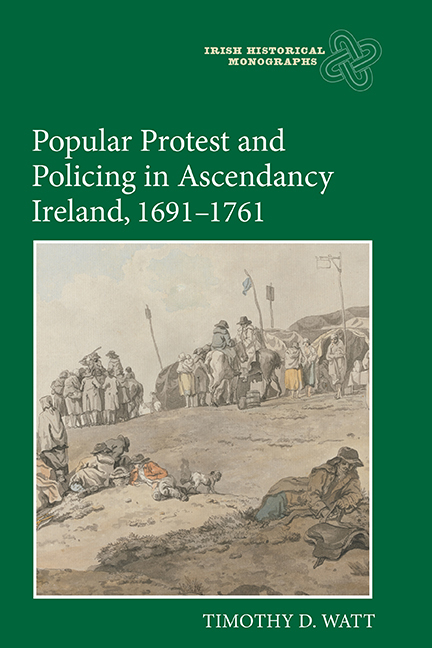Book contents
- Frontmatter
- Dedication
- Contents
- List of illustrations
- Acknowledgements
- Principal abbreviations
- Notes on conventions
- Glossary
- Introduction
- Part One Policing and large-scale disorder
- Part Two Popular Protest and Collective Action
- 4 ‘Mobs’, Authorities and Popular Politics
- 5 A ‘Rebellious Traditional Culture’ in Ireland
- 6 ‘Riot and Rescue’ and Anti-Taxation Protest
- 7 Journeymen, Masters and ‘Collective Bargaining by Riot’ in Dublin
- 8 Factional Gangs, Authorities and Corruption of the Law in Dublin
- 9 Conclusion
- Appendix: Irish Combination Acts, 1705–80
- Bibliography
- Index
- Irish Historical Monographs previous volumes
4 - ‘Mobs’, Authorities and Popular Politics
from Part Two - Popular Protest and Collective Action
Published online by Cambridge University Press: 12 October 2019
- Frontmatter
- Dedication
- Contents
- List of illustrations
- Acknowledgements
- Principal abbreviations
- Notes on conventions
- Glossary
- Introduction
- Part One Policing and large-scale disorder
- Part Two Popular Protest and Collective Action
- 4 ‘Mobs’, Authorities and Popular Politics
- 5 A ‘Rebellious Traditional Culture’ in Ireland
- 6 ‘Riot and Rescue’ and Anti-Taxation Protest
- 7 Journeymen, Masters and ‘Collective Bargaining by Riot’ in Dublin
- 8 Factional Gangs, Authorities and Corruption of the Law in Dublin
- 9 Conclusion
- Appendix: Irish Combination Acts, 1705–80
- Bibliography
- Index
- Irish Historical Monographs previous volumes
Summary
The term ‘mob’ was often found in newspapers and official correspondence in the early eighteenth century, but was in fact a relatively new expression. It is derived from the Latin phrase mobile vulgus, meaning ‘the moveable or excitable crowd’, and was usually used to describe violent popular protests involving members of the lower social orders. The vast majority of references to riots in England and Ireland, found in newspapers, official papers and pamphlets, describe ‘mobs’ in extremely negative ways. They were usually understood as harmful to society, both physically and morally, and terms such as ‘rabble’, ‘scum of the people’ and ‘lowest and basest rank of mankind’ were employed to describe those who took part in them. Newspapers normally concentrated on the harm done by crowds, the damage to property and personal injury, and rarely commented on the circumstances leading to violence breaking out. Newspaper reports of rioting in Cork in March 1729 stated that ‘the common people having assembled themselves in a tumultuous manner, armed with clubs and other instruments of mischief, broke open and plundered several granaries and store houses. … [It was] a terrible fray, in which tis said several were killed and 80 or 90 people desperately wounded’. The report did not refer to the economic hardships being endured by people in Cork, nor the widespread alarm caused by acute food shortages. It focused only on the level of lawlessness and destruction, and the importance of the forces of order. Pamphleteers also condemned rioters for undermining civil liberties and spreading ‘disorder and confusion’ among the people. Daniel Defoe, an outspoken critic of popular violence, claimed that ‘mobs of any party are in their nature destructive of government itself, ruinous to all the purposes of civil society, enemies to safety, order, justice, and policy among men’. It did not matter if rioters had just cause. He believed ‘a rabble raised for the most righteous purpose in the world has yet its fatal dangers attending it, which no good man can justify the running the risk of’.
This chapter examines two types of crowds or ‘mobs’ in Ireland in the late seventeenth and early eighteenth centuries: self-directing crowds and crowds controlled from above. First, self-directing crowds usually acted in the interests of the community to which their members belonged.
- Type
- Chapter
- Information
- Publisher: Boydell & BrewerPrint publication year: 2018



